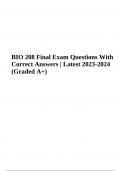Tentamen (uitwerkingen)
Introduction to Global Law II Midterm Exam Spring 2020 (Grade 8)
- Instelling
- Tilburg University (UVT)
This document contains the questions and my answers to the midterm exam of the course introduction to global law II where I received a grade of 8. Use this document as a study resource for practice exam questions
[Meer zien]













